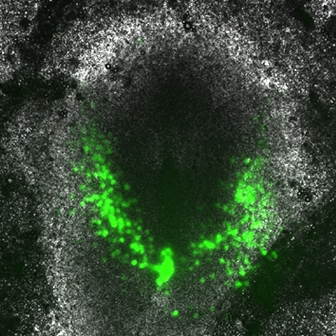UEA research identifies molecules that guide embryonic heart-forming cells

Image above shows an early chick embryo with prospective heart cells labeled in green. These cells are migrating towards the region where they will form the heart.
The heart is the first functioning organ to develop in humans, and correct formation is crucial for embryo survival and growth.
New research published today reveals how cells that form the heart, known as ‘cardiac progenitors’, are guided to move into the right place for the heart to begin to form.
It is hoped that the findings will help researchers better understand how congenital heart defects happen during the early stages of pregnancy.
Researchers studied live chick embryos and used a fluorescent dye to follow how prospective heart cells move together under the microscope.
Lead researcher Prof Andrea Münsterberg, from UEA’s School of Biological Sciences, said: “We have identified two important molecules which work together to control the correct migration of these cells.
They do this by responding to signals, which help the cells navigate their way together – a bit like the embryo’s own GPS system. Once they have arrived in the correct place, they can begin to form the heart.
“Exactly how the cardiac progenitor cells are guided in their movement by these external signals is still unclear, but we have identified two key players that are important in this process.
“This research is particularly important because correct heart formation, at the right time and in the right place, is crucial for embryos to survive and grow.”
The research was funded by British Heart Foundation project grants.
‘Smad1 transcription factor integrates BMP2 and Wnt3a signals in migrating cardiac progenitor cells’ is published in the journal PNAS (Proceedings of the National Academy of Sciences) on May 5.
Media Contact
More Information:
http://www.uea.ac.uk/mac/comm/media/press/2014/may/heart-cellsAll latest news from the category: Life Sciences and Chemistry
Articles and reports from the Life Sciences and chemistry area deal with applied and basic research into modern biology, chemistry and human medicine.
Valuable information can be found on a range of life sciences fields including bacteriology, biochemistry, bionics, bioinformatics, biophysics, biotechnology, genetics, geobotany, human biology, marine biology, microbiology, molecular biology, cellular biology, zoology, bioinorganic chemistry, microchemistry and environmental chemistry.
Newest articles

Trotting robots reveal emergence of animal gait transitions
A four-legged robot trained with machine learning by EPFL researchers has learned to avoid falls by spontaneously switching between walking, trotting, and pronking – a milestone for roboticists as well…

Innovation promises to prevent power pole-top fires
Engineers in Australia have found a new way to make power-pole insulators resistant to fire and electrical sparking, promising to prevent dangerous pole-top fires and reduce blackouts. Pole-top fires pose…

Possible alternative to antibiotics produced by bacteria
Antibacterial substance from staphylococci discovered with new mechanism of action against natural competitors. Many bacteria produce substances to gain an advantage over competitors in their highly competitive natural environment. Researchers…





















